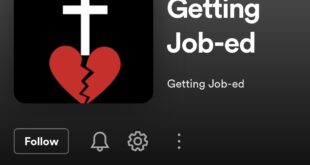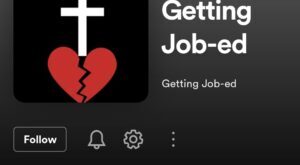*I will repost Jeremiah 31:31-34 at the beginning of each article in this series. Don’t skip it. Chew on it and let it sink in each time.
“Behold, the days are coming, declares the LORD, when I will make a new covenant with the house of Israel and the house of Judah, not like the covenant that I made with their fathers on the day when I took them by the hand to bring them out of the land of Egypt, my covenant that they broke, though I was their husband, declares the LORD. For this is the covenant that I will make with the house of Israel after those days, declares the LORD: I will put my law within them, and I will write it on their hearts. And I will be their God, and they shall be my people. And no longer shall each one teach his neighbor and each his brother, saying, ‘Know the LORD,’ for they shall all know me, from the least of them to the greatest, declares the LORD. For I will forgive their iniquity, and I will remember their sin no more.” Jeremiah 31:31-34 ESV
Much of the techniques that will be employed in examining this passage are found in the proceeding articles on How to study the Bible. The following is a paper written for Belhaven University as an exposition on the New Covenant seen in Jeremiah 31:31-34. :
The importance of the passage of Jeremiah 31:31-34 cannot be overstated. However, many factors must be taken into account while attempting to interpret this passage in its correct context while extracting its implications for God’s people on this side of the New Testament. The purpose of this paper is to: discuss how Jeremiah 31:31-34 relates to its historical and its literary context; compare and contrast the “New” Covenant and the “Old” Covenant; and finally, discuss what the canonical perspective of Jeremiah 31:31-34 was and how Christ fulfills this passage in the inauguration, continuation, and consummation of His Kingdom. To achieve this, we will employ historical, literary, and canonical analysis to examine the text.
Historical Context
While discussing a particular passage of Scripture, we must examine the historical aspects of the text. The Book of Jeremiah is likened to a work of anthology that is composed of both Jeremiah’s direct writings and also of stories about Jeremiah. (1) Jeremiah serves as a prophet both before and during the Babylonian siege and exile of Judah(2) as noted in 2 Kings 24-25. (3) Jeremiah was appointed by God to deliver the message for Judah to repent of their sins and of the warning of the consequences of breaking covenant with Yahweh, (4) to preach the sentence of judgment that is coming on Judah for their lack of repentance, and finally, to deliver the message of hope for a final restoration of the people of God. (5) The majority of Jeremiah’s confrontations were with King Jehoiakim and King Zedekiah of Judah and the people of Judah during their reigns. (6) The issue with Judah was not only the covenant that they have broken with Yahweh but also their lack of remorse and repentance to turn from their ways. Because of this, Babylon’s siege of Judah/Jerusalem was actually God’s judgment on the kings and people of Judah (2 Kings 24:2–4, Jeremiah 20:4–6, Jeremiah 21:10).
Literary Context
We will now turn our attention to the literary context of Jeremiah 31:31-34. Jeremiah 1-29 addresses the call to repentance for Judah’s sins and ultimately the judgment of Judah’s lack of repentance for breaking their covenant with Yahweh. (7) In a sense, Jeremiah 30-33 is a reversal of the judgments found in Jeremiah 1-29 with the restoration of the land and its people. (8) Interestingly, no information is given on the timeline of restoration for Jeremiah 30-33. (9) This poses a challenge but also an insight into the context of the restoration. Could the restoration that is to come to Israel and Judah be both near but may not be fully consummated until a later date in time? In this regard, it would be fitting to assume that God, who is inspiring Jeremiah to write these words, is employing the tactic as seen similar to the other prophetic books: both a near view that is closer to the date of the author’s writing and also a far view in regard to prophesy yet to occur. (10) We see that, historically, the people of Israel would return from exile and even rebuild the temple in Ezra 3. However, the temple apparently lacked the luster and splendor of God’s presence, as noted with the elders weeping in Ezra 3:12-13. This gives further weight to the fact that the restoration in Jeremiah 30-33 was not yet consummated even with Israel’s return from exile but rather pointed toward a greater reality.
Jeremiah 30-33 does not forsake the judgment that is coming on Israel, and I would argue, to the rest of the world. Eschatalogically, this section is not pointing towards a Universalism approach to salvation for everyone. We see this because judgment still resurfaces even in this section of Scripture but with a primary focus that is on restoration (for instance, Jeremiah 32:18). However, this section is pointing to God reversing the judgment of His people, to have a people that are able to follow God’s law (Jeremiah 31:33), God satisfying their soul’s desires and longings by giving Himself (Jeremiah 31:13-14, 25), and doing all of this by establishing a “branch” from King David who will “…execute justice and righteousness in the land” (Jeremiah 33:15 English Standard Bible). The concept of restoration through King David is further developed in Jeremiah 33:14-26.
The Old Covenants
Yahweh states in Jeremiah 31:31-32 that He will establish a New Covenant with Israel, and not like one that He had with their fathers. In the immediate sense in vs. 32, God is discussing the covenant with Moses. In a broader sense of Jeremiah 30-33, could God be implying also other covenants as well? The Adamic and Noahic Covenants were universal covenants with all people, so more than likely what God was also implying were the covenants made with Abraham, Moses, and David as well. The Abrahamic Covenant was made so that God would have a chosen people for Himself in a land that He designated with a sign of circumcision of all of the males (Genesis 12:1-3, 15:1-21, 17:1-14). The Mosaic Covenant involved God rescuing His people from slavery in Egypt and then giving them His law and statutes to follow in order for Him to be in their presence (Exodus 19-24). The Davidic Covenant stated that God would establish David’s lineage as a king forever (2 Samuel 7:1-17). Each covenant demands human loyalty and service, even the Davidic Covenant (2 Samuel 7:14). Aspects of each of these covenants can be seen throughout Jeremiah 30-33.
Footnotes
- Tim Mackie, Read Scripture: Illustrated Summaries of Biblical Books, 3rd ed., (Oregon, BibleProject, 2020), 34.
2. J. Daniel Hays and Tremper Longman III, The Message of the Prophets, (Michigan, Zondervan, 2010), 146.
3. Mackie, Read Scripture: Illustrated Summaries of Biblical Books, 34.
4. Mackie, Read Scripture: Illustrated Summaries of Biblical Books, 34.
5. Hays and Longman, The Message of the Prophets, 146.
6. Hays and Longman, The Message of the Prophets, 146.
7. Hays and Longman, The Message of the Prophets, 174.
8. Hays and Longman, The Message of the Prophets, 178.
9. Tremper Longman III, and David E. Garland, The Expositor’s Bible Commentary: Jeremiah-Ezekiel,
Revised ed., (Michigan, Zondervan, 2010), 366.
10. Hays and Longman, The Message of the Prophets, 80.
Bibliography
Hays, J. Daniel, and Longman, Tremper III, The Message of the Prophets, (Michigan,
Zondervan, 2010).
Longman, Tremper III, and Garland, David E., The Expositor’s Bible Commentary Volume 7:
Jeremiah-Ezekiel, Revised ed., (Michigan, Zondervan, 2010).
Mackie, Tim, Read Scripture: Illustrated Summaries of Biblical Books, 3rd ed., (Oregon,
BibleProject, 2020).
Piper, John, “The New Covenant and New Covenant People,” accessed November 15, 2022,
https://www.desiringgod.org/messages/the-new-covenant-and-the-new-covenant-people
Roberts, Vaughan, God’s Big Picture (Illinois, InterVarsity Press, 2002).
Third Millenium Ministries, “He Gave Us Prophets: Lesson 8: Unfolding Eschatology,” accessed
November 15, 2022, https://thirdmill.org/seminary/lesson.asp/vid/33
 Getting Job-ed
Getting Job-ed


